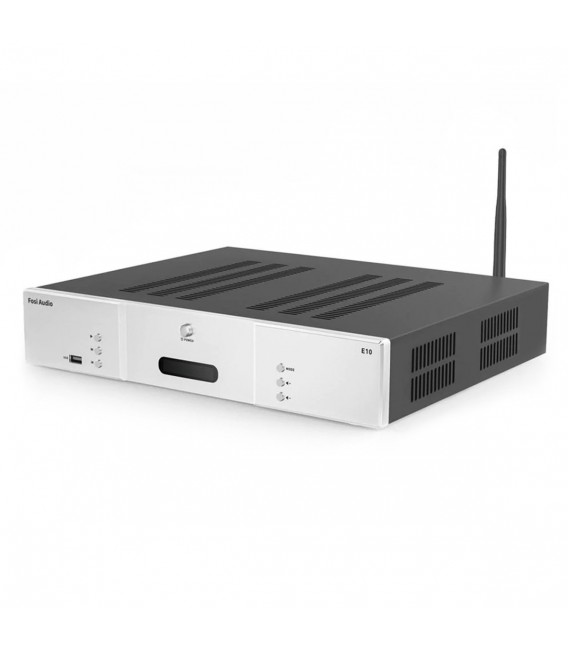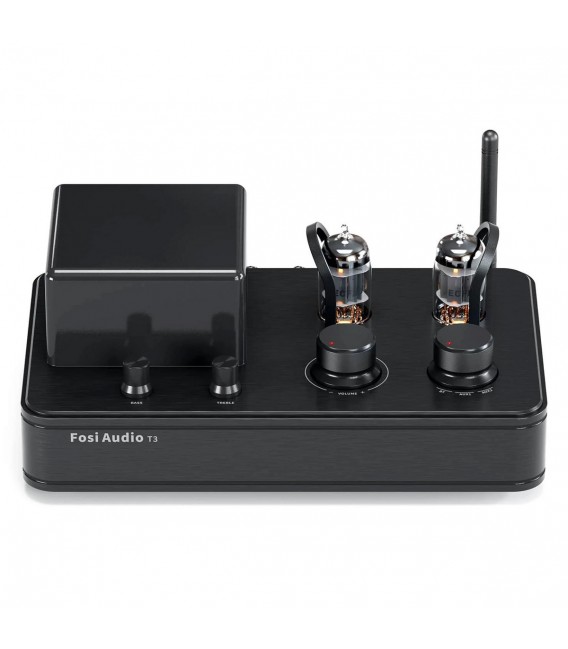-
WANTED: Happy members who like to discuss audio and other topics related to our interest. Desire to learn and share knowledge of science required. There are many reviews of audio hardware and expert members to help answer your questions. Click here to have your audio equipment measured for free!
You are using an out of date browser. It may not display this or other websites correctly.
You should upgrade or use an alternative browser.
You should upgrade or use an alternative browser.
Help Shape Our Next Innovation: The ZA5 Balanced Power Amplifier!
- Thread starter Fosi Audio
- Start date
-
- Tags
- fosiamp fosiaudio fosiaudioza5
Yet, for music, most folks don't need more than say 50 Watts at low distortion. Home cinema rigs are a different thing.In my experience, amplifier distortion is not a real problem, lack of power may be. Currently, I own a pair of Irs2092 monobloks: great power but a fair amount of load dependence. If you could design an IRS2092 power amp with PFFB, 800 watts, 85dB Sinad at less than 200$, it could be an interesting addition.
I'm not sure about that. 50 watts strikes me as a very low number. Mid-sensitive speakers, as my Lintons , in mid-sized room, require much more, at least if one's playing some dynamic music and applying a bit of eq.Yet, for music, most folks don't need more than say 50 Watts at low distortion. Home cinema rigs are a different thing.
Lednek
Member
- Joined
- Jan 17, 2023
- Messages
- 55
- Likes
- 46
I 100% agree, and I actually asked for a low pass filter. The high pass is the far more important feature. That being said, If both were included and well implemented, the roll off slope between high and low pass could be idealy implemented with less fiddling, measurement and adjustment for those who don't have the equipment or knowledge.Why put a low pass filter into the Fosi when 95% of subs and sub plate amps already have one built-in?
ScofieldKid
Active Member
Just take two of the v3 mono, put them in one box. If you want to make it sell, do a "dual mono" design, where both of the power supplies are better quality, and they are both contained within the chassis. Make sure the cooling is good.
So my 2 cents, focus on power supplies, cooling, single chassis.
So my 2 cents, focus on power supplies, cooling, single chassis.
At your price point, you really can't touch Purifi and it would probably be a stretch for Hypex, although I think some of the plate amps are at the top of your given price range.The new balanced model is ZA5, and we would like to get your opinions on a few aspects:
1. Choice of amplifier chip:
A. Hypex NCOREx
B. Purifi
C. TI TPA 3255
D. MOSFET class D amplifier (Do you have any recommended MOSFET brands?)
E. Other options
Who's your target audience?
I'd love to challenge you to do a Purify at a good price point. If you can... you'd kill the TPA 3255 based competition in terms of quality.
So... that would kind of kill the idea of a Purifi product?That would need certification to be sold in western countries,is not the same with the pre-certificated external PSUs.
Not sure how well they would sound if you were using a std brick power supply. Has anyone tested that combo?
Sokel
Master Contributor
- Joined
- Sep 8, 2021
- Messages
- 7,499
- Likes
- 7,761
Purifi,Hypex,Icepower modules require multiple voltages ,separate + and - (and ground of course) for the power rail supply and separate for the aux circuits for control,Vdrive,etc.So... that would kind of kill the idea of a Purifi product?
Not sure how well they would sound if you were using a std brick power supply. Has anyone tested that combo?
Can't do that with a brick.
why this power brick requirement? Fosi already sells amplifiers with built in power supply,

 www.audiosciencereview.com
www.audiosciencereview.com
some available in Europe, and quite cheap:

 www.audiophonics.fr
www.audiophonics.fr

 www.audiophonics.fr
www.audiophonics.fr

Fosi Audio HD-A1 Budget Amplifier Review
This is a review and detailed measurements of the Fosi Audio HD-A1 amplifier. It costs US $200 on Amazon including Prime shipping. It was kindly sent to me for testing by member @IowAudio. He has a review of it on youtube. The front is not bad for a budget product: The font could use some...
 www.audiosciencereview.com
www.audiosciencereview.com
some available in Europe, and quite cheap:

FOSI AUDIO E10 Amplifier TPA3251D2 MS8413 Bluetooth 5.0 24bit 192kHz 2x125W 4 Ohm - Audiophonics
The Fosi Audio E10 is a Class D amplifier that is both powerful, efficient and affordable. It embeds a TPA3251D2 amplifier chip allowing it to develop a comfortable power of 2*125W under 4Ω with a high efficiency, a low distortion...

FOSI AUDIO T3 Amplificateur à Tubes Class AB 2x 6F2 Bluetooth 5.0 2x50W 4 Ohm - Audiophonics
The Fosi Audio T3 is a small tube amplifier allowing to enjoy the sound signature of this round and warm type of amplification at a low price. It is thus equipped with two 6F2 tubes offering a power of 2x 50W under 4Ω.
Hmmm so how do Laptops do it?Purifi,Hypex,Icepower modules require multiple voltages ,separate + and - (and ground of course) for the power rail supply and separate for the aux circuits for control,Vdrive,etc.
Can't do that with a brick.
Sokel
Master Contributor
- Joined
- Sep 8, 2021
- Messages
- 7,499
- Likes
- 7,761
Do what?Hmmm so how do Laptops do it?
Which laptop contains any of above modules and requires voltage,amperage and control of that magnitude?
That's the point... if a laptop can use a brick for power... then you could use it for an amp like purify, but you'd have to include some bits to convert the voltage.Do what?
Which laptop contains any of above modules and requires voltage,amperage and control of that magnitude?
If memory serves and its been a while since I've looked at it... Don't laptops need 5volts and 3.5volts or something like that for components.
Note that I'm not saying to do it... because its already pointed out that Fosi already has products w built in power supplies.
IMHO I don't think that they could hit their price point w Purifi.
The eval kit just for the boards are roughly $700.00 then you need power supply and case.
Case is ~180.00 USD. (All my numbers are USD)
VTV sells an amp based on the kit. ~$900.00-$950.00 (Rough numbers)
Could Fosi hit the ~$600.00 target? (Which is north of their $300.00 target?
Maybe since they are manufacturers and could source the OEM Boards. 1ET400A which is the ~200Watts per channel at 8ohms. They would have to design, make their own 'header boards' , cases and then the power supply.
Depending on volume pricing of the Purifi cards, and their cost of the rest of the components... They could maybe do it? But it would be tight.
So they would hit Orchard,Buckeye, and VTV's niche.
Sokel
Master Contributor
- Joined
- Sep 8, 2021
- Messages
- 7,499
- Likes
- 7,761
The problem is not converting the voltage as with DC-DC voltage regulators and stuff.That's the point... if a laptop can use a brick for power... then you could use it for an amp like purify, but you'd have to include some bits to convert the voltage.
If memory serves and its been a while since I've looked at it... Don't laptops need 5volts and 3.5volts or something like that for components.
Note that I'm not saying to do it... because its already pointed out that Fosi already has products w built in power supplies.
IMHO I don't think that they could hit their price point w Purifi.
The eval kit just for the boards are roughly $700.00 then you need power supply and case.
Case is ~180.00 USD. (All my numbers are USD)
VTV sells an amp based on the kit. ~$900.00-$950.00 (Rough numbers)
Could Fosi hit the ~$600.00 target? (Which is north of their $300.00 target?
Maybe since they are manufacturers and could source the OEM Boards. 1ET400A which is the ~200Watts per channel at 8ohms. They would have to design, make their own 'header boards' , cases and then the power supply.
Depending on volume pricing of the Purifi cards, and their cost of the rest of the components... They could maybe do it? But it would be tight.
So they would hit Orchard,Buckeye, and VTV's niche.
Even if we ignore the >50V voltages for those modules we can't ignore their need to interact with their PSU,creating a closed system.
We have seen DIY efforts using various PSU's,but none taking advantage of the abilities of these new modules.
I'm not denying this.The problem is not converting the voltage as with DC-DC voltage regulators and stuff.
Even if we ignore the >50V voltages for those modules we can't ignore their need to interact with their PSU,creating a closed system.
We have seen DIY efforts using various PSU's,but none taking advantage of the abilities of these new modules.
And the point is that its moot.
The real question is going to be what they use for the surrounding components.
I don't know Purifi's OEM pricing.
The issues:
1) Header board. Fosi can design and build it without too much of a challenge.
2) Case. Again they have the capability to design and build out.
3) Power supply. This is the one thing that I have to question. Price and how quiet does it have to be?
If memory serves Erin did some reviews on Fosi kit and found that there was noise, however not really much of an issue when you consider that you would probably never hear it or notice it.
Then you have the options like XLR ... 12volt trigger... etc ...
I think based on their scale... a $600.00 USD target price might be possible.
And it would compete w Buckey, Orchard and VTV or the DIY kits.
Back in the day my 10W valve amp would drive 87db speakers to way beyond what my neighbours would tolerate. If you don't have that sort of restriction and like music with lots of bass played loud then yes more watts are great, but for most folks it is surprising how little you need. 30 or 40 Watts used to be considered a really powerful amp and the human ears haven't changed muchI'm not sure about that. 50 watts strikes me as a very low number. Mid-sensitive speakers, as my Lintons , in mid-sized room, require much more, at least if one's playing some dynamic music and applying a bit of eq.
This is an interesting question. I listen to classical music - a very dynamic kind of music - in a room of about 24 square meters. My app - Niosh slm - says that the average spl is 75-80 db, with 85-90 db max and LCpeak of 103-106 db. Now a rapid calculation gives that to get 106 db at 1 meter from an 85 db sensitive speaker I need 128 watts. So my guess is that to get better transients, especially with bass content and some eq, I need at least 200 watts. Of course, I may be wrong in my conjecture.Back in the day my 10W valve amp would drive 87db speakers to way beyond what my neighbours would tolerate. If you don't have that sort of restriction and like music with lots of bass played loud then yes more watts are great, but for most folks it is surprising how little you need. 30 or 40 Watts used to be considered a really powerful amp and the human ears haven't changed much
Middle Earth
Active Member
- Joined
- Nov 12, 2023
- Messages
- 126
- Likes
- 106
PurifiHello everyone, we are back seeking opportunities to co-create products with you.
Thanks to your continuous support, our ZA3, launched a few months ago, has been widely recognized by users. We greatly value the opportunity to discuss and develop new products with you. Now, we have started preparing the design for the next balanced power amplifier and hope you can continue to provide your valuable insights.
The new balanced model is ZA5, and we would like to get your opinions on a few aspects:
1. Choice of amplifier chip:
A. Hypex NCOREx
B. Purifi
C. TI TPA 3255
D. MOSFET class D amplifier (Do you have any recommended MOSFET brands?)
E. Other options
2. Based on the above options, what would be your price expectation for this product?
A. Around $200
B. Around $250
C. Around $300
If you have more suggestions, please let us know.
More than $300 but worth it
A pre-out and a sub out
If you can do it for “Around $300”
That would be quite an achievement
I don't think I would consider LCpeak values when sizing an amplifier - AFAIK it is some sort of differently measured peak to peak value used for noise level assessment not anything to do with music as we know it.This is an interesting question. I listen to classical music - a very dynamic kind of music - in a room of about 24 square meters. My app - Niosh slm - says that the average spl is 75-80 db, with 85-90 db max and LCpeak of 103-106 db. Now a rapid calculation gives that to get 106 db at 1 meter from an 85 db sensitive speaker I need 128 watts. So my guess is that to get better transients, especially with bass content and some eq, I need at least 200 watts. Of course, I may be wrong in my conjecture.
Just for fun, although it's not really relevant, I spotted a post from someone's first impressions after purchasing a used copy of my little old valve amp:
"
I recently purchased this amplifier
Audio Innovations 300. https://www.google.com/search?q=aud...r.org%2Fukra%2Fzoenedd%2Fzoenedd.html;852;358
10 watts per channel.
It was recently recapped by the previous owners technician.
I don't know if this is or isn't a problem:scratch2:
The speakers are Wharfedale 312's
55 litre
30mm woofer
200mm midrange
15mm Treble / horn
200 watt
35 Hz to 40 Khz
Sensitivity 97 Db at 1 meter
The volume is set at about 1 for comfortable listening.:music:
At 2 to 3 on the dial it becomes very very loud and I get complaints from my wife at that setting.:yes:
At 4 or 5 I would have the neighbours and police knocking on the door
This explains a lot of things!...
Sensitivity 97 Db at 1 meter
....
Similar threads
- Replies
- 153
- Views
- 18K
- Replies
- 826
- Views
- 120K
- Replies
- 708
- Views
- 198K
- Replies
- 124
- Views
- 22K
